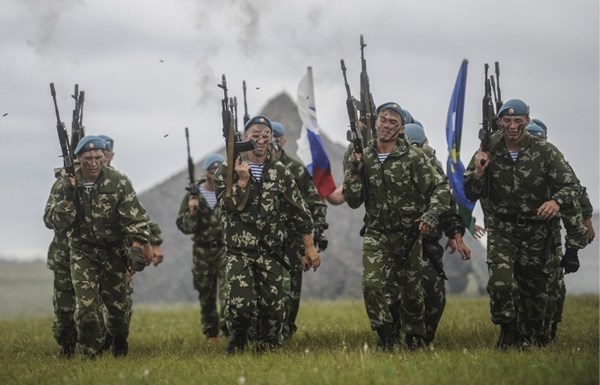Russia’s 10-km breakthrough near Pokrovsk exposes systemic gaps as Dobropillya comes under threat
Russian forces made a push on the Pokrovsk axis, advancing toward the village of Zolotyy Kolodyaz. Analysts say Moscow exploited a systemic weakness and may try to build on those gains.
Russian troops moved into Kucheriv Yar and Zolotyy Kolodyaz through sustained pressure and an advantage in infantry, and are now massing in the area, the DeepState monitoring group said on August 11.
From Kucheriv Yar, Russian forces “slipped” into Vesele and are also concentrating there. Moscow is pressing toward the Dobropillya–Kramatorsk highway and consolidating in the areas of Novovodyane and Petrovka.
“Unfortunately, the enemy probed for weak spots for further movement and will use them to carry out similar attempts,” the analysts warned.
DeepState said the breakthrough began with drone-enabled fire control, after which Russia identified spots for a physical advance. Once they dig in and build up, they will try to push deeper. The enemy is also expected to deploy more drone crews to complicate alternative logistics and the holding of nearby positions by Ukraine’s forces.
“With this trajectory, if it doesn’t change, we may run into a situation where Dobropillya falls faster than Pokrovsk,” the analysts stressed.
In its August 11 report, the Institute for the Study of War said Russian sabotage and reconnaissance groups are infiltrating areas near Dobropillya and that Moscow’s forces have seized a number of settlements southeast of the city.
“It is premature to characterize Russian advances near Dobropillya as an operational-level breakthrough, although Russian forces are likely attempting to expand their tactical gains to an operational-level breakthrough in the coming days. (...) The next several days in the Pokrovsk area will likely be critical for Ukraine’s ability to prevent accelerated Russian advances north and northwest of Pokrovsk,” U.S. analysts assessed.
On the evening of August 11, the operational tactical group command Dnipro said the situation around Dobropillya and Pokrovsk is difficult, with the most intense combat along the entire front occurring there. It noted that Russia is using numerical superiority, taking heavy losses while trying to infiltrate small groups past the first line of Ukraine’s defenses. Reserves are being committed, the command said, but it rejected claims of territory being occupied.
Ukraine’s General Staff also confirmed “seepage” by Russian forces on the Pokrovsk axis. The press service said Commander-in-Chief Oleksandr Syrskyi has allocated additional forces and assets to “identify and destroy enemy sabotage groups.”
In its morning update on August 12, the General Staff said Ukrainian Forces stopped 48 offensive actions by the Russians on the Pokrovsk axis. Fighting was reported near Poltavka, Popiv Yar, Mayak, Dorozhne, Nykanorivka, Kucheriv Yar, Novoe Shakhovo, Vladymyrivka, Novoekonomichne, Sukhetske, Rodynske, Luch, Udachne, Lisivka, Zverevo, Orikhove and Dachne.
Also on August 12, units of the Azov Corps took up a section of the defensive line on the Pokrovsk axis. The military said they have planned and are taking measures to block enemy forces,
Bohdan Krotevych, former chief of staff of the National Guard’s Azov Brigade, publicly appealed to President Volodymyr Zelenskyy on August 11, warning of a critical situation at the front. He said Pokrovsk and Myrnohrad are nearly encircled, while Kostyantynivka is in a partial encirclement.
Krotevych said the problem has been building since last year and that newly created corps or operational groups (OTG/OSUV) are not to blame for the “failed situation.” It began, he argued, with the “erasure” of reserves, the mass fragmentation of units along the front, and a lack of strategic and operational vision among parts of the military leadership.
Ukrainian soldier Stanislav Bunyatov said the Pokrovsk sector has faced several issues, including a shortage of personnel at positions and too few UAV crews.
“Such breakthroughs are clearly the result of an unrealistic assessment of one’s own forces and means, as well as of the enemy’s capabilities. There were signs pointing to such consequences in the near future, but they were not addressed in time,” he said, adding that the enemy turned a systemic problem to its advantage.
A senior lieutenant of the Defense Forces with the callsign “Alex” insisted Russia deserves no special credit for the breach, saying assaults of a similar nature are occurring along the line of contact and the enemy is not focusing on particular areas.
“Once again, we’re scoring an ‘own goal.’ The problem is no longer in some brigade or its commander, but broader — among those issuing orders at the operational-strategic level, and the sum of those orders has driven the situation to a critical point,” the officer said.
He confirmed the situation in Donetsk region is critical and expressed hope that top commanders will change priorities. In his view, if the occupied villages aren’t retaken and corridors aren’t cut, the breakthrough could create “major problems” at the operational or strategic level in the near future.
Maksym Zhorin, deputy commander of the 3rd Separate Assault Brigade, also rejected claims that the situation on the Pokrovsk axis is under control. He said the deterioration was caused by poor communication between units, ineffective use of forces, dishonesty at all levels, the absence of adequate decisions, and more. Stopping Russia’s advance is critical now, he warned, because continued success could lead to the capture of the entire Donetsk region.
Oleksandr Kovalenko, a military-political analyst with the Information Resistance group, said the Russian breach was driven not by poor defensive layouts but by a lack of effective communication among units. Moscow’s forces exploited the “seams” between zones of responsibility to push forward — not for the first time, he added. Ukrainian intelligence had warned about Russian force concentrations ahead of an offensive, but those warnings did not prompt decisions, he said.
Earlier, military expert Mykhailo Zhirohov cautioned Ukrainians to brace for bad news from the Pokrovsk sector, citing “a certain chaos” in command.
There were also reports of Russia moving equipment and forces to the Zaporizhzhia region. Expert Pavlo Lakiychuk said the Orikhiv and Hulyaipole sectors have become “an eyesore” for the Russians.
